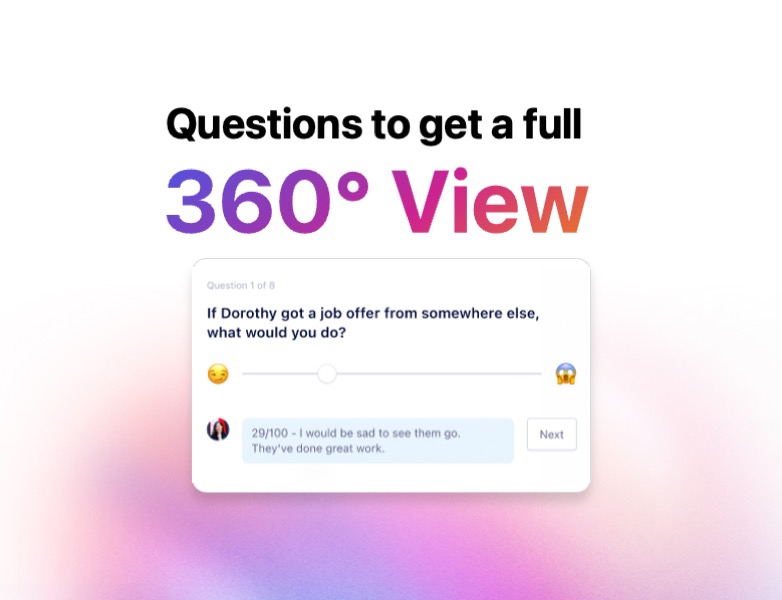The ultimate guide to having difficult conversations with employees
13 min read
We’ve been there.
Marcus hasn’t been hitting his deadlines for the past three weeks.
Sheryl has been making negative comments about her coworkers to anyone who will listen.
Jason has been taking two hour lunches, every single day.
Looks like it’s time for a difficult conversation. *Cringe* 😬
If you’re a manager, you’re going to need to get used to managing difficult conversations once in a while. They’re a part of the job – and, unfortunately, they’re not always easy.
Michael Lopp, author and Slack’s VP of Engineering, puts it succinctly:
“On the list of leadership merit badges, ‘Successfully deliver hard news’ is one the hardest badges to acquire. It’s not just that you have news, it’s hard news. It’s an honest something the human sitting across from you does not want to hear. Not only do you need to deliver it, but you need to successfully deliver it.”
Nervous? Don’t be. Our ultimate guide to having difficult conversations with employees will help you nail these conversations every step of the way.
Stay tuned to learn:
- What are difficult conversations, anyway?
- Why does it matter how you handle difficult conversations?
- Before the conversation
- During the conversation
- After the conversation
What are difficult conversations, anyway? 🤷♀️
The above quote from Michael Lopp brings up a good point: what exactly constitutes a difficult conversation? Are they always about delivering bad news?
According to Elizabeth Freedman, Principal at executive coaching firm Bates Communications, the most challenging conversations with employees are the ones that go beyond simple fact-based discussions to touch on topics more sensitive or personal in nature – and ones that were left to fester over time.
“These are often related to performance, lack of advancement, letting people go, aspects of behavior that are more nuanced like demeanor, hygiene or attitude,” she says.
“Sometimes it is not about what you are saying, but the fact that you didn’t say something in a timely way, that you have let an issue become more pronounced. When you don’t nip things in the bud, the discussion is much harder.”
But what are the most common conversations that tend to worry managers the most? Corporate trainer and executive coach Bruce Mayhew says there are three conversations that tend to come up the most often:
- “Annual performance reviews where there is an disconnect between what the employee expects and what management are sharing.”
- “An employee missing deliverables or submitting work that is not up to expected standards/quality.”
- “An employee not exhibiting the values and policies of their workplace. This often impacts respect for their coworkers, customers and suppliers.”
While performance issues are a key component of difficult conversations, there are many other conversations that might come up as well. Research from the Chartered Management Institute, for example, identified the 10 most challenging conversations to have at work – and the list included a few less work-related topics like family relationships and health.
And depending on your management style, you mind find certain conversations much easier to address than others. You might thrive, for example, resolving a conflict between two team members, but struggle when it comes to delivering negative feedback.
“Difficult conversations can be many things to many people,” says Bruce. “The important thing is how you handle them.”
Key takeaway: Difficult conversations can be on many topics, but are often related to performance, career conversations or more personal aspects of behaviour like attitude or demeanour.
Why does it matter how you handle difficult conversations?
How a manager handles difficult conversations can have a huge impact on their relationship with their team. A poorly-handled conversation can erode trust, and negatively impact morale and productivity – and that means your team isn’t reaching their goals.
In a presentation for Lean In on difficult conversations, Fred Kofman, director of the Conscious Business Center at Universidad Francisco Marroquín, outlines the importance of addressessing these conversations head-on:
“It is precisely at those times that communication is most vital to achieving your goals that conversations break down most dramatically. That’s why difficult conversations are scary – the stakes are high and there is a high cost to fail, and yet that’s where failure is most likely.”
That’s why it’s so important to learn – and follow – the proper steps to having difficult conversations with your employees. In the following sections, we’ll outline what to do before, during and after your conversations to make sure your difficult conversations go as smoothly as possible.
Key takeaway: When poorly handled, difficult conversations can have a serious impact on your team’s trust, morale and productivity.
Before the conversation
Preparing for difficult conversations 📋
Our number one tip for prepping for a difficult conversation? Don’t wing it.
“Even if you are an experienced leader or manager, take the time to really prepare ahead of the conversation,” explains Elizabeth Freedman.
“You need to be specific, concrete and clear. Collect your facts and support what you are saying with data. If you have particularly sensitive or hot button issue, make sure you have covered your bases with HR and others key stakeholders. Think through what you are going to say and also prepare for what they might say, and questions they may ask. It’s important to think through how you will be able to control your own emotions and anticipate where they will react or feel defensive.”
In other words, don’t YOLO hard conversations (thanks to Michael Lopp for that gem).
Here’s a checklist to go through prior to your conversation to help you prepare:
- Get the facts. Pull up any key metrics/dates/incidents related to your conversation ahead of time, and review the details. This is also a good time to review any relevant company policies or rules that pertain to the situation, or bring your HR team into the conversation.
- Step into their shoes. Take a moment to try to see the situation from all angles – including your employee’s. Don’t make any definitive assumptions, but push your brain to go beyond your own thinking.
- Acknowledge – and remove – any emotions. You’re human. You probably have associated some emotions with this situation. Are you angry? Disappointed? Worried? Spend some time with those feelings, and then push them aside. Bringing them into the conversation will only make things worse.
- Think about possible solutions. Again, this can’t be finalized without the conversation happening, but it’s worthwhile to think about what you’d like to happen. What are you hoping to achieve from this conversation? What might be a win-win solution?
- Create an objective statement. Once you’ve gone through all the above steps, you’ll be able to distill your objective down to one sentence for clarity. Try to break the sentence down into three parts: what seems to be happening, how it’s impacting the team and what you’d like to achieve.
Thinking about the logistics
An important component of a difficult conversation is figuring out what you want to say and why – but you’ll also want to take a minute to think about the when and where. Will this conversation take place during your scheduled one-on-one, or will it be a separate meeting? Is there a place in your office where you can speak privately?
Here are a few do’s and don’ts of setting up a difficult conversation:
- Do: Schedule plenty of time for the conversation. You don’t want to be rushing through – or have to end it prematurely.
- Don’t: Book a highly visible meeting space. A glassed-in conference room isn’t the best venue for this type of conversation.
- Do: Remove distractions. Choose a time and place where you can expect no interruptions or diversions.
- Don’t: Book the meeting too far in advance. You want to be talking about the issue at hand when it’s still recent and fresh in both your minds.
To add, or not to add? 🤔
 Not sure whether to add your difficult conversation to your Hypercontext one-on-one meeting agenda? After all, you don’t want to blindside them, but you also don’t want them to panic. One option is to approach your employee in person and let them know you’d like to set up a meeting to discuss an issue that has come up – then add it to your agenda.
Not sure whether to add your difficult conversation to your Hypercontext one-on-one meeting agenda? After all, you don’t want to blindside them, but you also don’t want them to panic. One option is to approach your employee in person and let them know you’d like to set up a meeting to discuss an issue that has come up – then add it to your agenda.
If you’re really not keen to bring it up beforehand, use your Private Notes section in your Hypercontext meeting agenda to jot down talking points and potential action items beforehand – only you’ll be able to see them, and you can always transfer them over to the shared agenda later, if needed. 👇
During the conversation
Having a meaningful conversation
As a manager, one of your top priorities should always be having meaningful conversations with your team. And that becomes especially important when it comes to the more challenging conversations that sometimes arise.
As we’ve already discussed, the first step in having a meaningful conversation is preparation. The “Before” section above will help you ensure you have a clear idea of what you want to say, and why.
But beyond the prep work, there’s a lot you can do to ensure you’re setting yourself (and your employee!) up for success.
Here are 6 tips from our experts for getting the most out of your difficult conversation:
- Focus on facts and real examples. “Stay away from words like always and never,” warns Bruce.
- Be really present. “Do not get distracted by your phone,” says Elizabeth. “Be in a quiet space where you can have the conversation uninterrupted. Be prepared to have the path forward defined about what happens next, once you leave the room.”
- Know your triggers. “What engages your fight and flight response, and what engages your collaborative response?” says Bruce. “Consider the employees triggers, too.”
- Show you care. “Recognize that it makes a difference to communicate and demonstrate there is a relationship beyond this conversation,” says Elizabeth. “Remember that it is a point in time, not the sum of an entire person’s history, worth or value. Think about how you are conveying to the person that you care about them and what happens to them.”
- Recognize the emotional impact. “Even bad news like ‘we are downsizing and have to let you’ go can be done respectfully,” says Bruce. “Recognize this is bad news and will have a significant human and emotional impact on the employee.”
- Be clear and honest. “Let people have hope – hope that the promotion is still an option or hope that they can expect to continue to progress on their path at a future date or once behaviors are addressed,” explains Elizabeth. “And equally importantly, if this is not an option, this should be clear too as part of the conversation. Giving false hope can damage both the employee and the manager’s reputation.”
The power of notes
 Here at Hypercontext, we love taking meeting notes – we’re obsessed with it, really. But we think it’s extra-super important when it comes to the more difficult conversations managers need to have with their team once in a while.
Here at Hypercontext, we love taking meeting notes – we’re obsessed with it, really. But we think it’s extra-super important when it comes to the more difficult conversations managers need to have with their team once in a while.
You’ll want to refer back to the meeting later on, so be sure to jot down what was discussed, and any next steps you’ve landed on together. It will help to ensure the challenging conversation doesn’t go wasted.
Is your conversation going badly? 😬
Worried the conversation will go off the rails without you knowing it?
Here’s the bad news: you might not know a conversation has gone badly right away. Or, it might seem to have gone poorly in the moment, but you’ll find out later your employee was just digesting the information.
“The reaction you get in the room is not necessarily the full picture of what the person is thinking and experiencing,” says Elizabeth. “Not everyone reacts visibly. Some people shut down or are not ready to process the information in the moment. It may take days or weeks to process the information.”
All the more reason to follow up afterward – but more on that later.
However, according to Bruce, there are some warning signs you can look for during the conversation to get a sense for whether an employee’s triggers (or your triggers) have been hit – a surefire sign things will go off the rails.
Look for these physical signs:
- Flushed cheeks
- A stiffer sitting position
- Sweaty palms
If you see these warning signs, it might be a good time to step back and check in with your employee. Ask how they’re feeling, and what they need from you to continue the conversation. They might even ask to pause the conversation as they process the information you’ve shared. That’s OK – just be sure to make a plan for when or how to continue the conversation.
Key takeaway: Keep an eye out for the warning signs that your employee has been triggered – but at the same time, bear in mind that not everyone reacts visually, and some people will need time to process the information discussed.
After the conversation
Following up after a difficult conversation
If you talk to your employee about their dipping performance at work, but then never follow up on the conversation, did it ever really happen?
“It is important that the follow up is not to rehash the conversation, but to acknowledge the mutual accountability and actions related to the next steps discussed in the room,” explains Elizabeth. “Helping to ensure that the path forward continues to be clear is key to follow up.”
But it’s also important to follow up to check in on the employee.
“Managers need to be very thoughtful about difficult conversations because there is a lot at stake, especially if the conversation doesn’t go as planned,” she says.
“You are having a difficult conversation because you want a different outcome. The question becomes, did you get a positive change out of the conversation? If you achieved that outcome it may be yes, but if it is at the expense of something bigger – someone is no longer motivated, or they are demoralized – it may not.”
The five-step follow-up plan:
- Following up should start the next day. Take a face-to-face moment to tell your employee that you appreciated the conversation you had.
- In the first few days after the meeting, offer your employee the chance to ask any follow-up questions or, if needed, continue the discussion. Make sure they feel like they got to share their side.
- In the days and weeks that follow, check in regularly on any action items you set in the meeting. Don’t badger them with daily follow-ups – every few days or once a week is fine.
- Celebrate positive progress promptly to keep them focused and motivated. Don’t let their hard work go unnoticed.
- If you see progress begin to falter, steer them back on track with a quick review of your meeting notes and action items. It shows them that you’re supporting them, and reminds them they’re going to be held accountable.
That’s it! 🎉 Hopefully this guide helps you to have more productive, meaningful conversations with your team. Remember to prepare beforehand, be engaged and present during the conversation and follow up afterward.
But most importantly, according to Elizabeth, remember to look at the bigger picture:
“Never forget that this is a relationship, and that you care about what happens beyond the conversation. Think about the greater objective, whether it is creating more success for the individual, the team, the organization. It is about making something better.”
Have better conversations with Hypercontext


